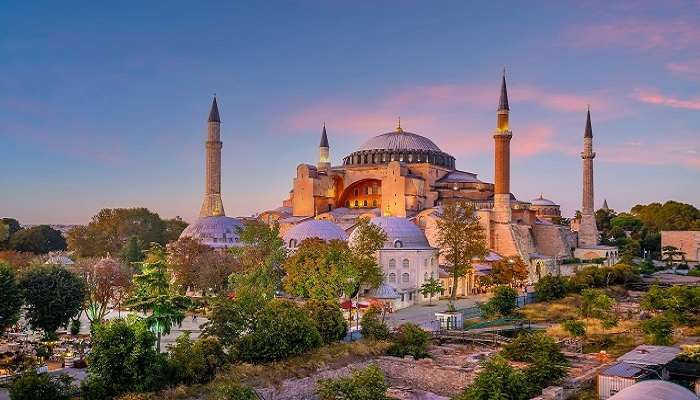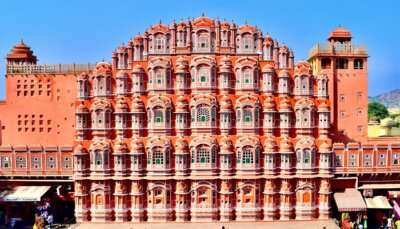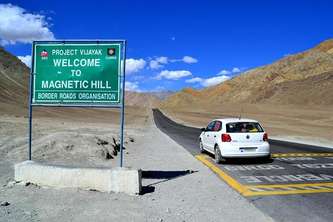Hagia Sophia Tour To Step Into Haven For A Memorable Experience

Hagia Sophia, a UNESCO World Heritage site, nestled in Istanbul, Turkey, is a remarkable architectural marvel that has stood the test for over 1,500 years. Originally built as a Christian cathedral in the 6th century under Emperor Justinian I, it later served as a mosque under the Ottoman Empire and now operates as a museum. The significance of Hagia Sophia Turkey lies not only in its architectural beauty but also in its cultural and religious heritage. Today, it continues to draw visitors from around the globe, inviting them to marvel at its splendour and ponder its storied past.
The Fascinating History Of Hagia Sophia

Hagia Sophia, originally built in 537 AD by the Byzantine Emperor Justinian I, is a testament to architectural ingenuity and cultural significance. Initially constructed as a Christian cathedral, it was the centre of Orthodox Christianity for nearly millennia. 1453 after the Ottoman conquest of Constantinople, it was converted into a mosque, undergoing significant architectural modifications.
In 1935, it was repurposed as a museum under the Republic of Turkey, reflecting its dual heritage as a symbol of Christian Byzantine and Islamic Ottoman legacies. Throughout its history, Hagia Sophia has endured as a focal point of cultural and religious identity, captivating visitors with its awe-inspiring beauty and historical resonance.
Must read: Things To Do In Turkey
Marvellous Architecture

Hagia Sophia is a masterpiece of architectural innovation, blending Byzantine and Islamic design elements into a structure that has captivated the world for over a millennium. Its most iconic feature is its massive dome, which, upon completion in 537 AD, was the largest in the world and remained so for nearly a thousand years. The dome appears to float effortlessly above the central nave, supported by a system of pendentives and semi-domes that distribute its weight gracefully to the ground. This architectural feat not only showcases the engineering prowess of its builders but also creates a sense of awe-inspiring grandeur for visitors.
The interior of Hagia Sophia is adorned with an array of breathtaking mosaics, marble pillars, and intricate calligraphy, reflecting its dual heritage as both a Christian cathedral and a Muslim mosque. Byzantine mosaics depicting religious figures and scenes from the life of Christ coexist harmoniously with Islamic calligraphy and motifs, creating a unique fusion of artistic styles. Outside, the exterior of Hagia Sophia is adorned with imposing minarets, added after the Ottoman conquest of Constantinople in 1453. These towering structures complement the domed silhouette of the building, adding to its imposing presence on the Istanbul skyline.
Suggested Read: Things To Do In Istanbul
Timings

During the tourist season, typically from April to October, Hagia Sophia is open to visitors every day of the week, including weekends. The operating hours generally span from early morning to late afternoon, with variations depending on the day of the week.In contrast, during the off-peak season, which falls between November and March, the museum may have reduced operating hours and may even be closed on certain days of the week, typically Mondays.
Additionally, it’s essential to consider any special events, renovations, or religious holidays that may affect the opening hours of Hagia Sophia. For instance, during Islamic holidays, such as Ramadan or Eid al-Fitr, the museum may have adjusted timings or even temporary closures.
Unknown Facts About Hagia Sophia

- Some lesser-known facts about Hagia Sophia include that it has remarkably survived numerous earthquakes over the centuries. This resilience is attributed to its innovative architectural design, including the unique pendentive system supporting its massive dome.
- Beneath layers of plaster added during the Ottoman period, Hagia Sophia conceals ancient Christian mosaics dating back to its time as a Byzantine cathedral. Some of these mosaics have been uncovered and restored, offering glimpses into the building’s earlier Christian heritage.
- Some researchers believe that Hagia Sophia was intentionally aligned with astronomical phenomena, such as the summer solstice and the rising of certain stars. These alignments may have held symbolic significance for the builders and served practical purposes in religious rituals.
- Others believe that beneath the surface of Hagia Sophia lie hidden chambers, passageways, and cisterns that have yet to be fully explored. These underground spaces, some of which date back to earlier periods of the site’s history, add to the intrigue and mystery surrounding this iconic landmark.
Suggested read: Istanbul Travel Tips
Interesting Legends Associated With Hagia Sophia

Hagia Sophia, steeped in centuries of history and religious significance, has inspired numerous legends and tales over the years. One of the most famous legends surrounding Hagia Sophia is the Whispering Gallery. It’s said that if you stand in one corner of the gallery and whisper, your voice can be heard clearly by someone standing in the opposite corner. This phenomenon is attributed to the unique acoustics created by the dome shape and the marble surfaces’ reflective properties. Embedded in the marble floor of Hagia Sophia are several large round medallions, whose origins are shrouded in mystery. According to legend, these medallions mark the spots where emperors and sultans stood to be crowned. Some tales even suggest that stepping on these medallions brings good fortune or fertility.
During the Ottoman conquest of Constantinople in 1453, legend has it that a mysterious white light emanated from the dome of Hagia Sophia, signalling divine protection for the city’s defenders. This light is said to have deterred the advancing Ottoman forces and bolstered the morale of the Byzantine defenders, although historical accounts vary. Like many ancient structures, Hagia Sophia is rumoured to contain hidden chambers and secret passages where treasures are said to be buried. Some legends claim that these treasures include relics, ancient manuscripts, or even the remains of saints. Despite extensive archaeological investigations, no concrete evidence of these hidden treasures has ever been found.
Further read: Places To Visit In Turkey
Hagia Sophia is a testament to the creative genius of its builders and the rich cultural heritage of the civilizations that have called it home. It inspires wonder and admiration as one of the world’s most iconic and enduring architectural achievements. Next time you plan a trip to Istanbul, Turkey do not forget to visit the marvellous and majestic Hagia Sophia as a journey to Hagia Sophia is not just a visit to a historical monument; it’s a voyage through centuries of human creativity, resilience, and cultural exchange.
For our editorial codes of conduct and copyright disclaimer, please click here.
Cover Image Source: Shutterstock
Frequently Asked Questions About Hagia Sophia
What is the exact location of Hagia Sophia?
The exact Hagia Sophia location is Ayasofya Meydanı, Sultanahmet, Fatih, Istanbul, 34122, Turkey.
What is the entrance fee for Hagia Sophia?
The Hagia Sophia entrance fee for visiting varies depending on whether you are a Turkish citizen or a foreign visitor. For Turkish citizens, admission to Hagia Sophia is typically free with a valid identification card or passport. To enter Hagia Sophia, tourists must pay a fee of EUR 25 (INR 2,235). However, this entry fee gives access to only a part of the mosque.
What is the Little Hagia Sophia?
The 'Little Hagia Sophia,' is called so because of its architectural resemblance to the larger and more famous Hagia Sophia. Originally known as the Church of Saints Sergius and Bacchus, the Little Hagia Sophia was built in the 6th century during the Byzantine period.
What can I see inside Hagia Sophia?
Inside Hagia Sophia, visitors can admire its massive dome, intricate mosaics, marble pillars, and other architectural features. There are also exhibitions showcasing artefacts and historical information about the building's history.
Can one take photographs inside Hagia Sophia?
Photography policies may vary, but generally, photography for personal use is allowed inside Hagia Sophia. However, flash photography and tripods may be restricted.
People Also Read:
Hotels In Istanbul Homestays In Istanbul Waterfalls In Istanbul

Embrace the essence of surreal places around the world through perfect narratives with a touch of imagination. As a content writer, I weave my ideas and words together to create a vivid picture of alluring destinations. Embark on limitless adventures as you read thrilling travel stories.











